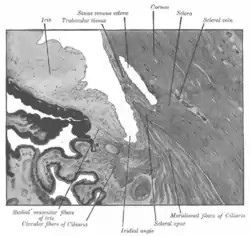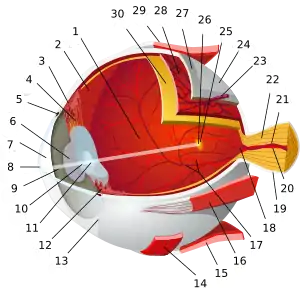Schlemm's canal
Schlemm's canal is a circular lymphatic-like vessel in the eye. It collects aqueous humor from the anterior chamber and delivers it into the episcleral blood vessels. Canaloplasty may be used to widen it.
| Schlemm's canal | |
|---|---|
 Anterior part of the human eye, with Canal of Schlemm at lower right. | |
 The upper half of a sagittal section through the front of the eyeball. (Canal of Schlemm labeled at center left.) | |
| Details | |
| System | eye |
| Identifiers | |
| Latin | sinus venosus sclerae |
| TA98 | A12.3.06.109 |
| FMA | 51873 |
| Anatomical terminology | |
Structure
Schlemm's canal is an endothelium-lined tube, resembling that of a lymphatic vessel.[1][2][3] On the inside of the canal, nearest to the aqueous humor, it is covered and held open by the trabecular meshwork.[4] This creates outflow resistance against the aqueous humor.[1]
Development
While Schlemm's canal has generally been considered as a vein or a scleral venous sinus, the canal is similar to the lymphatic vasculature. It is never filled with blood in physiological settings as it does not receive arterial blood circulation.[5] Schlemm's canal displays several features of lymphatic endothelium, including the expression of PROX1, VEGFR3, CCL21, FOXC2, but lacked the expression of LYVE1 and PDPN.[1][2][3] It develops via a unique mechanism involving the transdifferentiation of venous endothelial cells in the eye into lymphatic-like endothelial cells.[1][2][3]
This developmental morphogenesis of the canal is sensitive to the inhibition of lymphangiogenic growth factors.[1] In adults, the administration of the lymphangiogenic growth factor VEGFC enlarged the Schlemm's canal, which was associated with a reduction in intraocular pressure.[1]
In the combined absence of angiopoietin 1 and angiopoietin 2, Schlemm's canal and episcleral lymphatic vasculature completely failed to develop.[6]
Function
Schlemm's canal collects aqueous humor from the anterior chamber. It delivers it into the episcleral blood vessels via aqueous veins.[7][1][2][3]
Clinical significance
Canaloplasty
Canaloplasty is a procedure to restore the eye’s natural drainage system to provide sustained reduction of intraocular pressure. Microcatheters are used in a simple and minimally invasive procedure. A surgeon will create a tiny incision to gain access to Schlemm's canal. A microcatheter circumnavigates Schlemm's canal around the iris, enlarging the main drainage channel and its smaller collector channels through the injection of a sterile, gel-like material called viscoelastic. The catheter is then removed and a suture is placed within the canal and tightened. By opening Schlemm's canal, the pressure inside the eye is relieved.[8][9][10][11]
Angiopoietin deficiency
Schlemm's canal and episcleral lymphatic vasculature completely failed to develop in the combined absence of angiopoietin 1 and angiopoietin 2.[6] This causes buphthalmos and glaucoma.[6]
History
Schlemm's canal is named after Friedrich Schlemm (1795–1858), a German anatomist.
Additional images
 Enlarged general view of the iridial angle. (Labeled with older label of 'sinus venosus scleræ' at center top.)
Enlarged general view of the iridial angle. (Labeled with older label of 'sinus venosus scleræ' at center top.)
See also
References
- Aspelund, Aleksanteri; Tammela, Tuomas; Antila, Salli; Nurmi, Harri; Leppänen, Veli-Matti; Zarkada, Georgia; Stanczuk, Lukas; Francois, Mathias; Mäkinen, Taija; Saharinen, Pipsa; Immonen, Ilkka; Alitalo, Kari (2014). "The Schlemm's canal is a VEGF-C/VEGFR-3-responsive lymphatic-like vessel". The Journal of Clinical Investigation. 124 (9): 3975–86. doi:10.1172/JCI75395. PMC 4153703. PMID 25061878.
- Park, Dae-Young; Lee, Junyeop; Park, Intae; Choi, Dongwon; Lee, Sunju; Song, Sukhyun; Hwang, Yoonha; Hong, Ki Yong; Nakaoka, Yoshikazu; Makinen, Taija; Kim, Pilhan; Alitalo, Kari; Hong, Young-Kwon; Koh, Gou Young (2014). "Lymphatic regulator PROX1 determines Schlemm's canal integrity and identity". The Journal of Clinical Investigation. 124 (9): 3960–74. doi:10.1172/JCI75392. PMC 4153702. PMID 25061877.
- Kizhatil, Krishnakumar; Ryan, Margaret; Marchant, Jeffrey K.; Henrich, Stephen; John, Simon W. M. (2014). "Schlemm's canal is a unique vessel with a combination of blood vascular and lymphatic phenotypes that forms by a novel developmental process". PLOS Biology. 12 (7): e1001912. doi:10.1371/journal.pbio.1001912. PMC 4106723. PMID 25051267.
- Johnson, M. C.; Kamm, R. D. (1983-03-01). "The role of Schlemm's canal in aqueous outflow from the human eye". Investigative Ophthalmology & Visual Science. 24 (3): 320–325. ISSN 1552-5783.
- Ramos RF, Hoying JB, Witte MH, Daniel Stamer W. (2007). "Schlemm's canal endothelia, lymphatic, or blood vasculature?". J Glaucoma. 16 (4): 391–405. doi:10.1097/IJG.0b013e3180654ac6. PMID 17571003. S2CID 30363152.
{{cite journal}}: CS1 maint: uses authors parameter (link) - Thomson BR, Heinen S, Jeansson M, Ghosh AK, Fatima A, Sung HK, Onay T, Chen H, Yamaguchi S, Economides AN, Flenniken A, Gale NW, Hong YK, Fawzi A, Liu X, Kume T, Quaggin SE (2014). "A lymphatic defect causes ocular hypertension and glaucoma in mice". The Journal of Clinical Investigation. 124 (10): 4320–24. doi:10.1172/JCI77162. PMC 4191022. PMID 25202984.
{{cite journal}}: CS1 maint: uses authors parameter (link) - Cassin, B. and Solomon, S. Dictionary of Eye Terminology. Gainesville, Florida: Triad Publishing Company, 1990.
- "Video Journal of Ophthalmology - Streaming Video". Archived from the original on 2011-07-14.
- "Journal of Cataract & Refractive Surgery".
- "Journal of Cataract & Refractive Surgery".
- "Journal of Cataract & Refractive Surgery".
External links
- Histology image: 08005loa – Histology Learning System at Boston University
- Diagram
- Diagram
